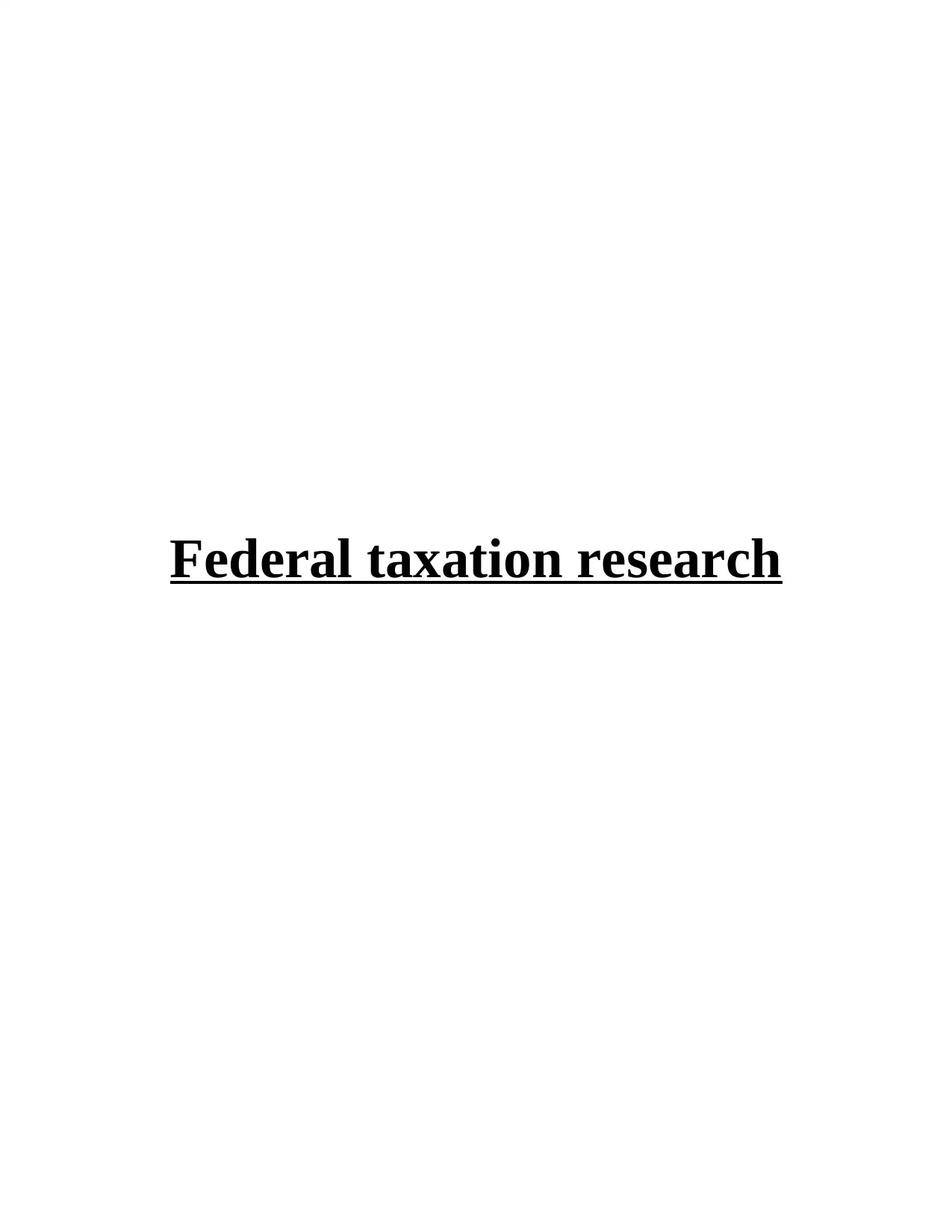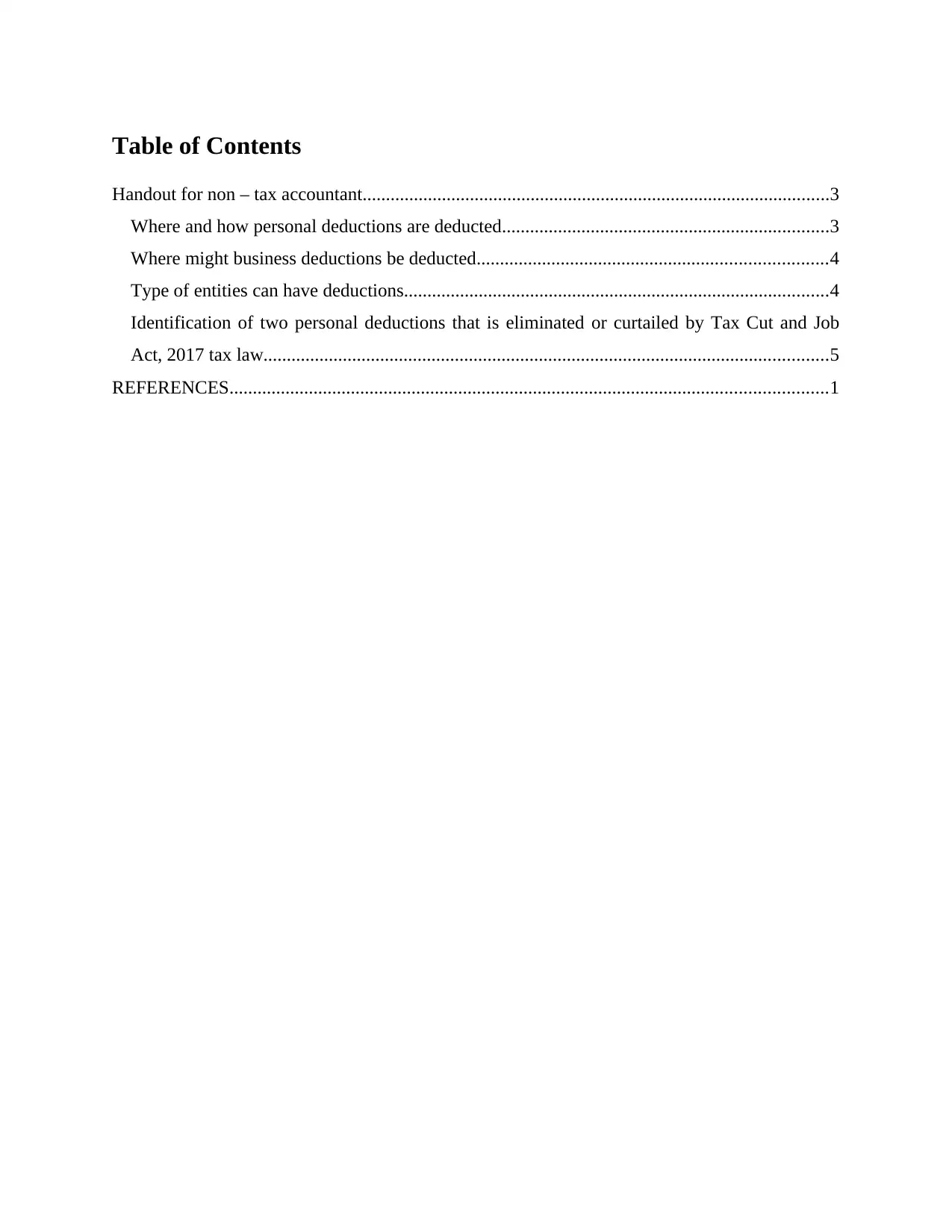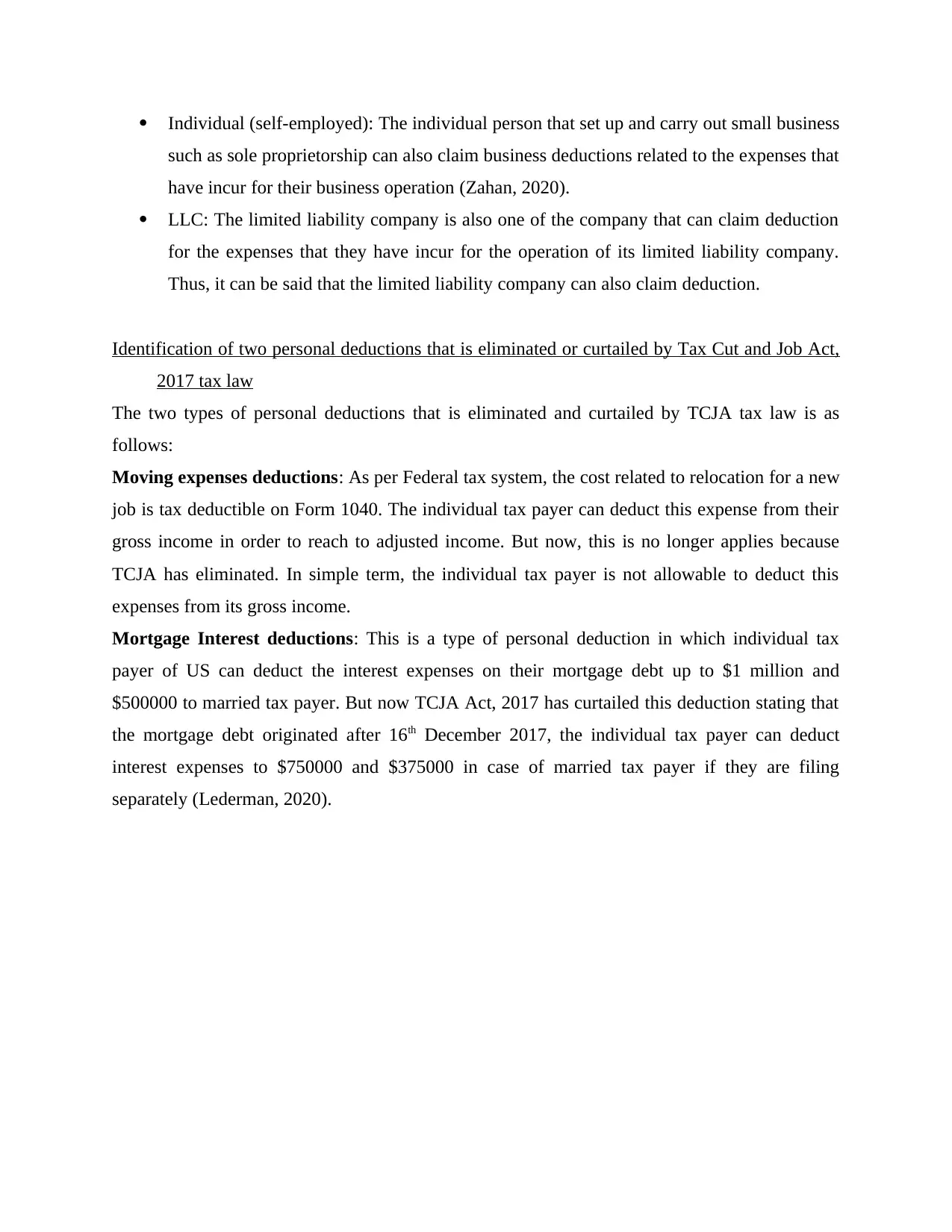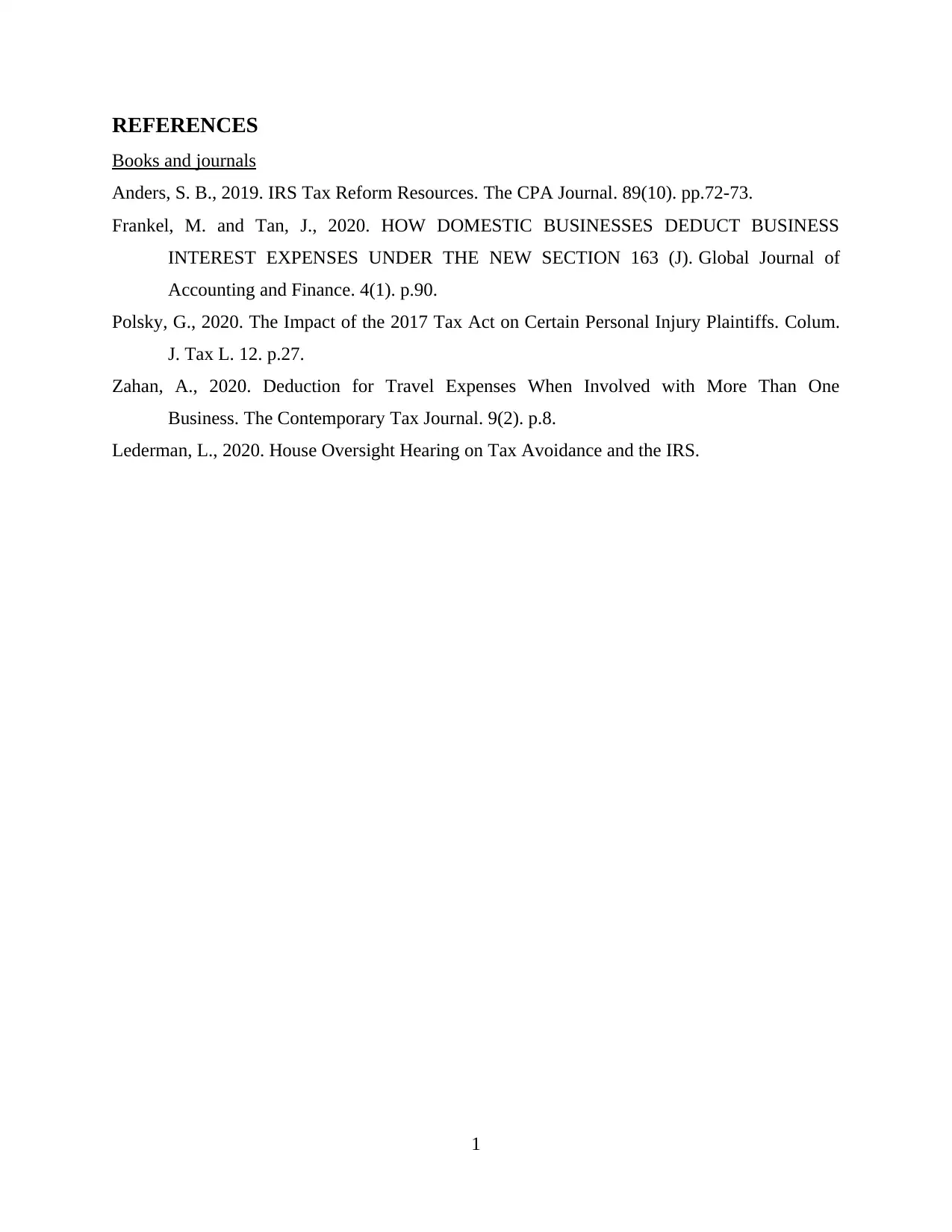Federal Taxation Research: Handout on Deductions and Tax Cuts 2017
VerifiedAdded on 2023/06/10
|6
|1300
|269
Report
AI Summary
This document is a handout designed for non-tax accountants, providing a concise overview of federal taxation. It covers the crucial aspects of personal and business deductions, including where and how they are deducted, and the types of entities eligible for deductions. The handout details various categories of personal deductions, such as itemized deductions and education deductions, and clarifies where business deductions can be claimed, specifying relevant forms like Form 2106 and Form 8829. Furthermore, it identifies two significant personal deductions, moving expenses and mortgage interest deductions, that were either eliminated or curtailed by the Tax Cuts and Jobs Act of 2017. The document provides a clear understanding of current tax laws and regulations, making it a valuable resource for accountants needing to stay informed about tax guidance. The content is supported by referencing relevant books and journals.

Federal taxation research
Paraphrase This Document
Need a fresh take? Get an instant paraphrase of this document with our AI Paraphraser

Table of Contents
Handout for non – tax accountant....................................................................................................3
Where and how personal deductions are deducted......................................................................3
Where might business deductions be deducted...........................................................................4
Type of entities can have deductions...........................................................................................4
Identification of two personal deductions that is eliminated or curtailed by Tax Cut and Job
Act, 2017 tax law.........................................................................................................................5
REFERENCES................................................................................................................................1
Handout for non – tax accountant....................................................................................................3
Where and how personal deductions are deducted......................................................................3
Where might business deductions be deducted...........................................................................4
Type of entities can have deductions...........................................................................................4
Identification of two personal deductions that is eliminated or curtailed by Tax Cut and Job
Act, 2017 tax law.........................................................................................................................5
REFERENCES................................................................................................................................1

Handout for non – tax accountant
Where and how personal deductions are deducted
Personal deductions are meant for reducing the taxable income by taking into account
several expenses that are allowable from tax authority to be deducted against the income of an
individual. All the personal deductions are allowed to be deducted on Schedule A (Form 1040).
There are several categories of deductions available to an individual, which are as follows:
Itemized deductions: It refers to the amount paid for income or sales tax or any other taxes such
as personal and real estate taxes, charitable contributions, etc. These amounts are deducted as an
expense from adjusted gross income which leads to reduction in taxable income and accordingly,
the owed amount of tax (Anders, 2019). This type of personal deduction is deducted where the
standard deduction can be used. For instance, large uninsured medical and dental expenses can’t
be claimed as standard deduction and accordingly, these expenses can be itemized but it is must
that these expenses should be included in Schedule A (Form 1040).
Education deduction: The amount borrowed for educational purpose and paid thereon can be
deducted as expense up to the amount of $2500 directly on Form 1040. This amount is capped at
$2500 and thus is useful for those who pay less interest than this amount.
Health care deduction: Deductions for expenses such as medical and dental care are allowed for
that amount only which is exceeding the 7.5% of the adjusted gross income.
Meals Deductions: According to Consolidated Appropriation Act (CAA), 2021 the businesses
can claim temporary allowances on meal deductions at the rate 100% as long as the expenses is
for food and beverages provided by the restaurant. The provision related to the deduction of meal
expenses of business is effective from the date Dec. 31st 2020 and expire at the end of the year
2022 (Frankel and Tan, 2020). The businesses can deduct its meal expenses from their business
income in order to figure out the adjusted taxable income on which the businesses need to pay
tax at the specified tax rate.
Where and how personal deductions are deducted
Personal deductions are meant for reducing the taxable income by taking into account
several expenses that are allowable from tax authority to be deducted against the income of an
individual. All the personal deductions are allowed to be deducted on Schedule A (Form 1040).
There are several categories of deductions available to an individual, which are as follows:
Itemized deductions: It refers to the amount paid for income or sales tax or any other taxes such
as personal and real estate taxes, charitable contributions, etc. These amounts are deducted as an
expense from adjusted gross income which leads to reduction in taxable income and accordingly,
the owed amount of tax (Anders, 2019). This type of personal deduction is deducted where the
standard deduction can be used. For instance, large uninsured medical and dental expenses can’t
be claimed as standard deduction and accordingly, these expenses can be itemized but it is must
that these expenses should be included in Schedule A (Form 1040).
Education deduction: The amount borrowed for educational purpose and paid thereon can be
deducted as expense up to the amount of $2500 directly on Form 1040. This amount is capped at
$2500 and thus is useful for those who pay less interest than this amount.
Health care deduction: Deductions for expenses such as medical and dental care are allowed for
that amount only which is exceeding the 7.5% of the adjusted gross income.
Meals Deductions: According to Consolidated Appropriation Act (CAA), 2021 the businesses
can claim temporary allowances on meal deductions at the rate 100% as long as the expenses is
for food and beverages provided by the restaurant. The provision related to the deduction of meal
expenses of business is effective from the date Dec. 31st 2020 and expire at the end of the year
2022 (Frankel and Tan, 2020). The businesses can deduct its meal expenses from their business
income in order to figure out the adjusted taxable income on which the businesses need to pay
tax at the specified tax rate.
⊘ This is a preview!⊘
Do you want full access?
Subscribe today to unlock all pages.

Trusted by 1+ million students worldwide

Where might business deductions be deducted
The various forms that needs to be filed by Businesses in order to claim or deduct business
deductions are as follows:
Business Travel Expenses: The businesses can deduct and claim the business travel
expenses on Form 2106 (Employee Business Expenses) and further report them on Form
1040 or Form 1040-SR as an adjustment to income.
Business use of home: The form businesses need to file in order to deduct expenses
related to business use of home is Form 8829. This form helps to figure out the allowable
expenses for business use of home on Schedule C (Form 1040) and any carryover amount
not deductible in previous years (Polsky, 2020).
Business use of car: Form 2106 employee business expenses is a form that need to be
filed by the businesses in order to deduct its business expenses if the tax payer is armed
forces reservist, a qualified performing artist, fee-basis state or local government
officials. For example, the self-employed car expenses deduct on Schedule C (Form
1040) for sole proprietorship and Schedule F (Form 1040) if the tax payer is farmer.
Here, the tax payer can figure out the deductions for their car expenses (Polsky, 2020).
Meals Deduction: Usually tax payer need to file Form 2106-EZ for their meal
deductions. However, if they are not required to file Form 2106-EZ then the form that tax
payer need to file in order to deduct its meal expenses is Schedule A (Form 1040),
Schedule A (Form 1040NR). As per US tax system, the tax payer can deduct only 50% of
their business meal expenses and entertainment expenses if they have incurred while
remaining away from home on business.
Type of entities can have deductions
Basically, the types of entities can have business deductions are as follows:
Corporation: This are the limited company which is operated by more than one owner
and they can deduct the expenses related to business.
Partnership: The partnership is a form where two or more partner set up and carry
business together a claim business deduction to compute partnership taxable income.
The various forms that needs to be filed by Businesses in order to claim or deduct business
deductions are as follows:
Business Travel Expenses: The businesses can deduct and claim the business travel
expenses on Form 2106 (Employee Business Expenses) and further report them on Form
1040 or Form 1040-SR as an adjustment to income.
Business use of home: The form businesses need to file in order to deduct expenses
related to business use of home is Form 8829. This form helps to figure out the allowable
expenses for business use of home on Schedule C (Form 1040) and any carryover amount
not deductible in previous years (Polsky, 2020).
Business use of car: Form 2106 employee business expenses is a form that need to be
filed by the businesses in order to deduct its business expenses if the tax payer is armed
forces reservist, a qualified performing artist, fee-basis state or local government
officials. For example, the self-employed car expenses deduct on Schedule C (Form
1040) for sole proprietorship and Schedule F (Form 1040) if the tax payer is farmer.
Here, the tax payer can figure out the deductions for their car expenses (Polsky, 2020).
Meals Deduction: Usually tax payer need to file Form 2106-EZ for their meal
deductions. However, if they are not required to file Form 2106-EZ then the form that tax
payer need to file in order to deduct its meal expenses is Schedule A (Form 1040),
Schedule A (Form 1040NR). As per US tax system, the tax payer can deduct only 50% of
their business meal expenses and entertainment expenses if they have incurred while
remaining away from home on business.
Type of entities can have deductions
Basically, the types of entities can have business deductions are as follows:
Corporation: This are the limited company which is operated by more than one owner
and they can deduct the expenses related to business.
Partnership: The partnership is a form where two or more partner set up and carry
business together a claim business deduction to compute partnership taxable income.
Paraphrase This Document
Need a fresh take? Get an instant paraphrase of this document with our AI Paraphraser

Individual (self-employed): The individual person that set up and carry out small business
such as sole proprietorship can also claim business deductions related to the expenses that
have incur for their business operation (Zahan, 2020).
LLC: The limited liability company is also one of the company that can claim deduction
for the expenses that they have incur for the operation of its limited liability company.
Thus, it can be said that the limited liability company can also claim deduction.
Identification of two personal deductions that is eliminated or curtailed by Tax Cut and Job Act,
2017 tax law
The two types of personal deductions that is eliminated and curtailed by TCJA tax law is as
follows:
Moving expenses deductions: As per Federal tax system, the cost related to relocation for a new
job is tax deductible on Form 1040. The individual tax payer can deduct this expense from their
gross income in order to reach to adjusted income. But now, this is no longer applies because
TCJA has eliminated. In simple term, the individual tax payer is not allowable to deduct this
expenses from its gross income.
Mortgage Interest deductions: This is a type of personal deduction in which individual tax
payer of US can deduct the interest expenses on their mortgage debt up to $1 million and
$500000 to married tax payer. But now TCJA Act, 2017 has curtailed this deduction stating that
the mortgage debt originated after 16th December 2017, the individual tax payer can deduct
interest expenses to $750000 and $375000 in case of married tax payer if they are filing
separately (Lederman, 2020).
such as sole proprietorship can also claim business deductions related to the expenses that
have incur for their business operation (Zahan, 2020).
LLC: The limited liability company is also one of the company that can claim deduction
for the expenses that they have incur for the operation of its limited liability company.
Thus, it can be said that the limited liability company can also claim deduction.
Identification of two personal deductions that is eliminated or curtailed by Tax Cut and Job Act,
2017 tax law
The two types of personal deductions that is eliminated and curtailed by TCJA tax law is as
follows:
Moving expenses deductions: As per Federal tax system, the cost related to relocation for a new
job is tax deductible on Form 1040. The individual tax payer can deduct this expense from their
gross income in order to reach to adjusted income. But now, this is no longer applies because
TCJA has eliminated. In simple term, the individual tax payer is not allowable to deduct this
expenses from its gross income.
Mortgage Interest deductions: This is a type of personal deduction in which individual tax
payer of US can deduct the interest expenses on their mortgage debt up to $1 million and
$500000 to married tax payer. But now TCJA Act, 2017 has curtailed this deduction stating that
the mortgage debt originated after 16th December 2017, the individual tax payer can deduct
interest expenses to $750000 and $375000 in case of married tax payer if they are filing
separately (Lederman, 2020).

REFERENCES
Books and journals
Anders, S. B., 2019. IRS Tax Reform Resources. The CPA Journal. 89(10). pp.72-73.
Frankel, M. and Tan, J., 2020. HOW DOMESTIC BUSINESSES DEDUCT BUSINESS
INTEREST EXPENSES UNDER THE NEW SECTION 163 (J). Global Journal of
Accounting and Finance. 4(1). p.90.
Polsky, G., 2020. The Impact of the 2017 Tax Act on Certain Personal Injury Plaintiffs. Colum.
J. Tax L. 12. p.27.
Zahan, A., 2020. Deduction for Travel Expenses When Involved with More Than One
Business. The Contemporary Tax Journal. 9(2). p.8.
Lederman, L., 2020. House Oversight Hearing on Tax Avoidance and the IRS.
1
Books and journals
Anders, S. B., 2019. IRS Tax Reform Resources. The CPA Journal. 89(10). pp.72-73.
Frankel, M. and Tan, J., 2020. HOW DOMESTIC BUSINESSES DEDUCT BUSINESS
INTEREST EXPENSES UNDER THE NEW SECTION 163 (J). Global Journal of
Accounting and Finance. 4(1). p.90.
Polsky, G., 2020. The Impact of the 2017 Tax Act on Certain Personal Injury Plaintiffs. Colum.
J. Tax L. 12. p.27.
Zahan, A., 2020. Deduction for Travel Expenses When Involved with More Than One
Business. The Contemporary Tax Journal. 9(2). p.8.
Lederman, L., 2020. House Oversight Hearing on Tax Avoidance and the IRS.
1
⊘ This is a preview!⊘
Do you want full access?
Subscribe today to unlock all pages.

Trusted by 1+ million students worldwide
1 out of 6
Related Documents
Your All-in-One AI-Powered Toolkit for Academic Success.
+13062052269
info@desklib.com
Available 24*7 on WhatsApp / Email
![[object Object]](/_next/static/media/star-bottom.7253800d.svg)
Unlock your academic potential
Copyright © 2020–2025 A2Z Services. All Rights Reserved. Developed and managed by ZUCOL.





